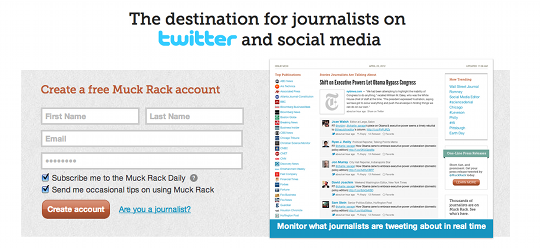How to use Twitter to engage journalists?
Recent studies have shown that journalists increasingly use social media and Twitter in particular as a source for stories. This trend is bound to increase.

As a consequence many of our clients want to know how they can best use Twitter to engage journalists. They want to know the proper etiquette, the dos and don’ts of how to catch an influential person’s attention and make that person an ally, someone who will help carry a message further.
Like most things social media we argue that this is a question of having something to offer. Without bringing something of value, something useful, to the table, there is little point trying to engage a journalist who is looking for the angle that will make his or her story publishable.
It’s a quid pro quo game really. For why should a journalist give you or your company the time of day if there’s nothing in it for them?
As soon as you adopt a mindset that’s not about “you” or your company, but about meeting the needs of the journalist you’re trying to engage, you’re on the right track.
Below we’ve outlined what we believe are the key principles to engaging journalists through Twitter. We’ve also added the best practical tips to make sure you’re not wasting efforts.
The importance of having a newsworthy story
If you have a relevant and newsworthy story most journalists will need no coaxing. But having a highly newsworthy story is rare.
What makes a story newsworthy often depends on the credibility and the context of the person sharing the story, prior relationships established, the angle chosen – how the story resonates with what is currently being talked about in social media and offline.
Building credibility
A story that comes directly from a recognised authority will immediately gain credibility.
This can be done by introducing a subject matter expert over time – starting to break down the sense of facelessness that comes with a corporate account, using videos, pictures and references to the work a particular person has been doing.
If personalised but still work-related Twitter accounts are an alternative for your organisation, the main corporate account can promote the work and message of the subject matter experts by re-tweeting their messages.
Building relationships
Relationships are established on Twitter much the same way they are in real life. Being “present”, commenting, providing help and suggestions, are all ways to build a rapport that goes beyond the purely instrumental.
It helps if a journalist knows who’s behind a corporate Twitter account. They need to know how to get in touch and deal with a real person. So put a face or at least a name and a title in the Twitter bio. And make clear who’s running the account at press conferences or at any other occasions when media staff spends time with journalists.
Once a personal rapport is established It’s OK to be more informal on Twitter, to just say hi. But don’t push content or ideas if there is no obvious opportunity to do so. The relationship and trust must build over time. Focus on those who are receptive to your tweets. Don’t waste time on people who don’t reply or re-tweet.
Getting the angle right
Having established a few relationships with key journalists, both online and offline, and having followed these over time, it will be easier to know what angle and timing to use.
But as emphasised above the story still needs to be relevant to the journalist you’re targeting. There is no point pitching a softer CSR story to a financial reporter.
The key to getting the angle right is to know the informational needs of the subject matter journalists, to send them the right nugget of information when they need it.
This means that it’s important to know your subject matter as well as the journalist and therefore be able to anticipate what angle to go for when.
So use internal subject matter experts to get the angle and the timing right, perhaps including a quote from them in the tweet, or even better letting them build the rapport with the journalist through their own Twitter feed.
Finding fertile ground
There is little point publishing a lot of information about a certain topic if there is little chance the content will resonate in the prevailing online and offline discussion-climate.
It is key to spend time listening and reading to find the fertile ground where a well-placed story can start to grow.
And it’s often easier to add something to an already existing debate or topic than starting a whole new one alone. Where the conversation is going the audience is already listening.
A journalist will be looking to write a story about a topic that’s “hot”. Provide that journalist with a piece of information that will give the story the push it needs, and you’re likely to be mentioned in a positive way.

Key practical tips
- Find and follow them – Find the journalists you want to influence before you need to reach them. If you know who you are looking for you can find them using Twitter Search. If not, Klout is a good way to find influential journalists. If the info there is not sufficient Muckrack is another good place to find journalists on Twitter.
- Get to know them – Respond to journalists’ Tweets now and again, even the ones that are non-work related. It’s the casual interactions that often build relationships. Read the stories they re-tweet to be able to deliver meaningful feedback. Attention & smart feedback are the purest forms of flattery. If they Tweet their own writing make sure you read that.
- Make them feel good – Making someone feel singled out in a positive way is an age-old way of making someone feel good about their work, and there is no exception for journalists and online pundits. Re-tweet their tweets, and mention them (@twitterhandle) when you think what you have to say is particularly relevant for them. It might feel awkward to do so at first, but it works and starts to build a closer relationship.
- Use Twitter lists – If you want to follow hundreds of journalists on several subjects make lists of these. It will make it easier to monitor all the conversations. And the lists will provide value to the people who follow you.
- If you have a story you’d like to seed… … Wait for the best moment to seed it. It can be better to be seen to be joining part of an existing conversation, rather than to be perceived as cold calling. So wait for that tweet that gives you an opportunity to respond.
- Give a journalist a scoop – Make sure you don’t always send out the same information to everyone. This has worked in PR and works online. Next time you have a story that need legs they will be much more likely to carry it for you. You can direct message (DM) someone for this to work, but remember that this only works if someone has already followed you back. We recommend this approach only when you have established a relationship already.
Here are a few sources for your further reading
From poynter.org: Most journalists now get story ideas from social media sources, survey says
Report in PDF format from the Oriella PR Network: The influence game: How news is sourced and managed today
